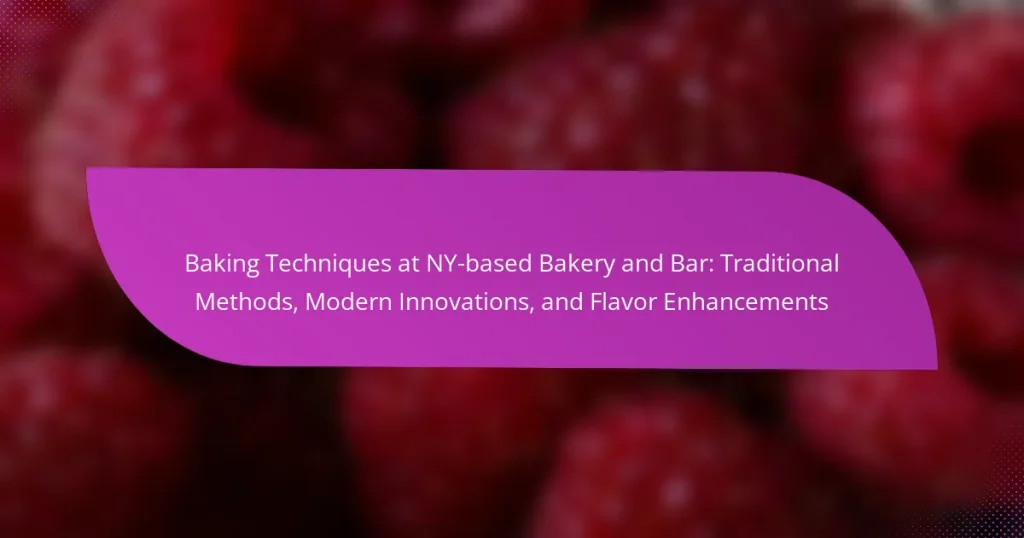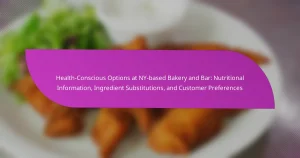The NY-based Bakery and Bar employs a combination of traditional baking techniques and modern innovations to create high-quality baked goods. Key methods include sourdough fermentation, laminated dough preparation, and the use of sous vide for precise temperature control. The bakery emphasizes artisanal craftsmanship, utilizing high-quality ingredients and unique spice blends to enhance flavor. Seasonal adaptations incorporate fresh, local produce, while precise measurements and temperature management ensure consistency and optimal results. This hybrid approach not only honors baking heritage but also embraces contemporary methods to improve product quality and customer satisfaction.
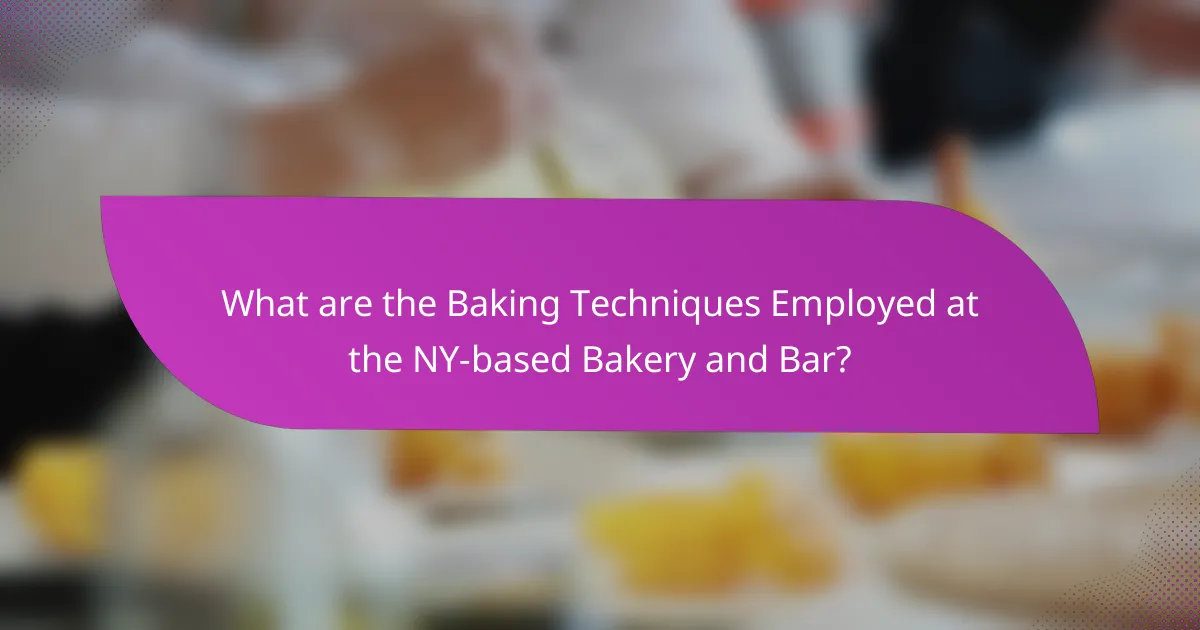
What are the Baking Techniques Employed at the NY-based Bakery and Bar?
The NY-based Bakery and Bar employs a variety of baking techniques. These include traditional methods like sourdough fermentation and laminated dough preparation. They also utilize modern innovations such as sous vide for precise temperature control. Flavor enhancements are achieved through the use of high-quality ingredients and unique spice blends. The bakery focuses on artisanal craftsmanship, ensuring each product is made with care. Techniques are adapted seasonally to incorporate fresh, local produce. Each method contributes to the overall quality and taste of the baked goods.
How do Traditional Methods Influence the Baking Process?
Traditional methods influence the baking process by emphasizing techniques that enhance flavor and texture. These methods often include slow fermentation, which develops complex flavors in bread. Techniques such as hand-kneading create a unique dough structure, contributing to a better crumb. Traditional baking often relies on natural leavening agents, like sourdough starters, which improve digestibility. The use of stone ovens, common in traditional baking, provides even heat distribution, resulting in a superior crust. Historical practices show that artisan bakers have perfected these methods over centuries, leading to distinctive regional flavors. Studies indicate that these traditional techniques can significantly improve the overall quality of baked goods.
What are the key traditional baking techniques used?
Key traditional baking techniques include mixing, kneading, proofing, and baking. Mixing combines ingredients to form a dough or batter. Kneading develops gluten, enhancing the texture of bread. Proofing allows dough to rise, creating air pockets for a light structure. Baking transforms raw dough into a finished product through heat. These techniques have been used for centuries, ensuring consistent results in bread and pastry making. Historical texts indicate that these methods date back to ancient civilizations, emphasizing their foundational role in baking.
How do these methods enhance the quality of baked goods?
Baking methods enhance the quality of baked goods by improving texture, flavor, and appearance. Techniques such as fermentation develop complex flavors through the action of yeast. This process also creates a lighter, airier texture in breads. Additionally, precise temperature control during baking ensures even cooking and optimal crust formation. The use of high-quality ingredients elevates taste and nutritional value. Methods like steaming can add moisture, resulting in softer pastries. Incorporating modern innovations, such as sous-vide, can further refine consistency and flavor extraction. These enhancements lead to a superior overall product that satisfies consumer preferences.
What Modern Innovations are Transforming Baking Practices?
Modern innovations transforming baking practices include advanced baking technology, automation, and ingredient science. Smart ovens with precise temperature controls ensure consistent results. 3D printing technology allows for intricate designs and custom molds. Automation in mixing and kneading improves efficiency and reduces labor costs. Ingredient innovations, like gluten-free and plant-based alternatives, cater to diverse dietary needs. Digital platforms facilitate recipe sharing and collaboration among bakers. These advancements enhance quality, creativity, and accessibility in baking.
What new technologies are being integrated into baking?
New technologies being integrated into baking include automated mixing machines and precision ovens. Automated mixing machines enhance consistency and efficiency in dough preparation. Precision ovens utilize advanced temperature control for optimal baking results. Additionally, 3D printing technology is being explored for creating intricate cake designs. Smart sensors are also being used to monitor dough fermentation and baking processes. These innovations improve product quality and reduce labor costs. Research indicates that automation in baking can increase production efficiency by up to 30%.
How do these innovations improve efficiency and flavor?
Innovations in baking techniques improve efficiency and flavor through advanced equipment and ingredient optimization. High-speed mixers reduce mixing time, allowing for quicker production. Automated ovens ensure consistent baking temperatures, enhancing product quality. Precision temperature controls lead to better flavor development in baked goods. Ingredient innovations, like enzyme-rich flour, improve dough handling and texture. These enhancements result in a more uniform product with richer flavors. Studies show that modern techniques can increase throughput by up to 30%. This combination of efficiency and flavor quality appeals to consumers and boosts sales.
What Flavor Enhancements are Utilized in Baking?
Flavor enhancements utilized in baking include extracts, spices, and zests. Common extracts are vanilla, almond, and lemon. Spices like cinnamon, nutmeg, and ginger add warmth and depth. Citrus zests, such as orange and lemon, provide brightness and freshness. Additionally, flavor enhancers like buttermilk and yogurt contribute tanginess. Chocolate and coffee intensify sweetness and richness. Natural sweeteners, such as honey and maple syrup, offer unique flavors. These enhancements elevate baked goods, making them more appealing and flavorful.
What ingredients are commonly used for flavor enhancement?
Common ingredients used for flavor enhancement include herbs, spices, extracts, and acids. Herbs such as basil and rosemary add freshness to dishes. Spices like cinnamon and nutmeg provide warmth and depth. Extracts, including vanilla and almond, contribute sweetness and complexity. Acids such as lemon juice and vinegar brighten flavors and balance richness. These ingredients are widely recognized in culinary practices for their ability to elevate taste profiles.
How do flavor enhancements affect customer satisfaction?
Flavor enhancements significantly improve customer satisfaction. They elevate the sensory experience of food. Enhanced flavors can lead to higher perceived quality. Customers often associate rich flavors with freshness and craftsmanship. According to a study published in the Journal of Food Science, 78% of consumers prefer products with enhanced flavors. This preference directly correlates with repeat purchases and customer loyalty. Flavor enhancements can also differentiate a product in a competitive market. Overall, they play a crucial role in shaping positive customer perceptions and experiences.
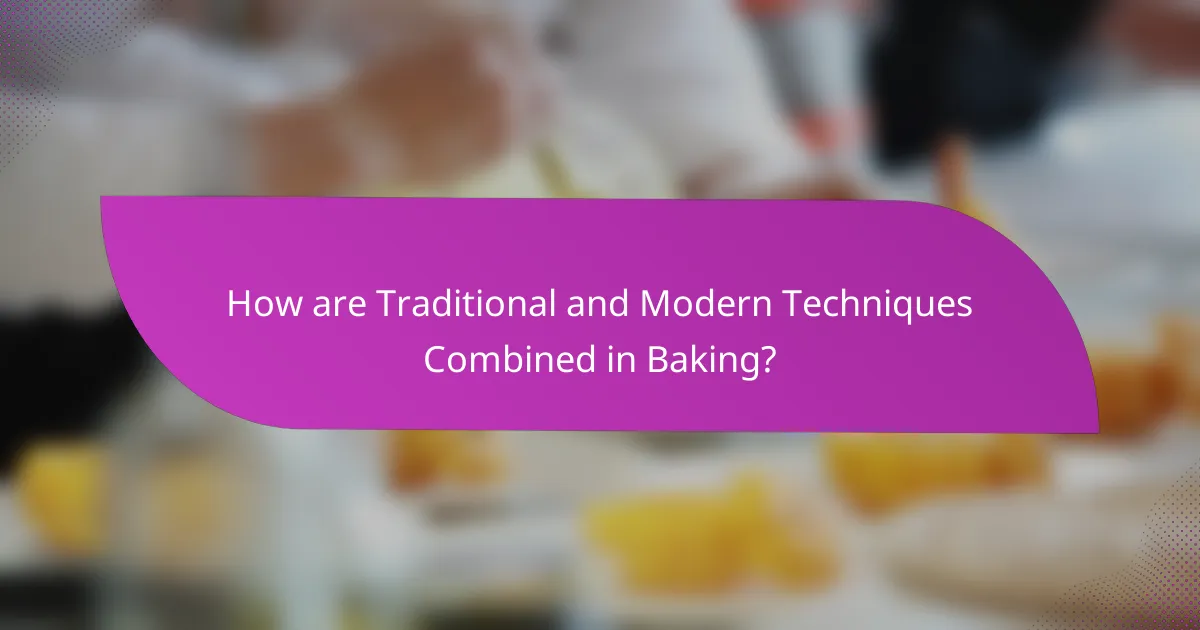
How are Traditional and Modern Techniques Combined in Baking?
Traditional and modern techniques in baking are combined through the integration of classic recipes with contemporary methods. Bakers often start with foundational techniques, such as fermentation and dough handling, which have been used for centuries. They then incorporate modern tools, like temperature-controlled ovens and precise measuring devices.
This combination allows for improved consistency and flavor development. For instance, using sourdough starters enhances the taste while modern mixers streamline the mixing process. Additionally, innovative flavor enhancements, such as infusions or alternative ingredients, are applied to traditional baked goods.
Research shows that this hybrid approach can improve product quality and customer satisfaction. A study by the American Baking Association highlights how blending these techniques leads to unique flavor profiles and textures. This method not only honors baking heritage but also embraces innovation for a contemporary audience.
What are the benefits of blending traditional and modern methods?
Blending traditional and modern methods enhances baking by combining time-honored techniques with innovative practices. This approach preserves the authenticity of classic recipes while infusing creativity and efficiency. Traditional methods often yield rich flavors and textures, while modern techniques can improve consistency and reduce preparation time. For example, using traditional fermentation alongside modern temperature control can enhance the flavor profile of bread. Additionally, integrating modern technology, such as precision baking equipment, allows for better quality control. Overall, this fusion results in superior baked goods that appeal to diverse consumer preferences.
How do bakers ensure consistency while innovating?
Bakers ensure consistency while innovating by standardizing recipes and procedures. They meticulously measure ingredients to maintain precise ratios. Consistent mixing techniques are applied to achieve uniform texture. Bakers also utilize temperature controls during baking to ensure even results. They often document each batch’s process for future reference. This documentation helps in replicating successful innovations. Additionally, taste tests are conducted to maintain flavor profiles. Feedback from these tests guides further adjustments in recipes.
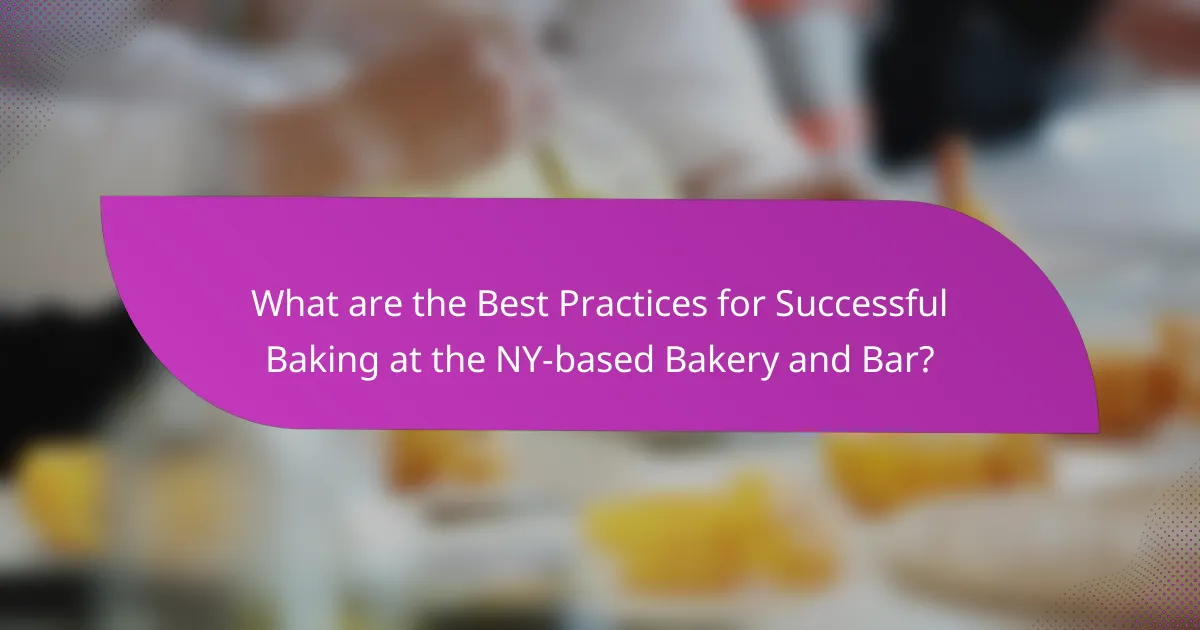
What are the Best Practices for Successful Baking at the NY-based Bakery and Bar?
Implementing precise measurements is crucial for successful baking at a NY-based bakery and bar. Accurate ingredient ratios ensure consistency in texture and flavor. Utilizing high-quality ingredients enhances the overall quality of baked goods. Maintaining an optimal baking temperature is essential for achieving the desired rise and crust. Regularly calibrating ovens can prevent temperature fluctuations that affect baking results. Following established recipes helps in replicating successful outcomes. Incorporating seasonal ingredients can elevate flavors and appeal to customers. Lastly, continuous training for staff on techniques and trends fosters innovation and quality. These practices collectively contribute to successful baking operations in a competitive environment.
What tips can improve baking outcomes?
Use precise measurements for ingredients to ensure consistency. Accurate measurements prevent discrepancies in texture and flavor. Utilize fresh ingredients for optimal taste and performance. Fresh ingredients enhance the overall quality of baked goods. Preheat the oven before baking to achieve even cooking. An adequately preheated oven ensures proper rising and browning. Rotate baking trays halfway through to promote uniform baking. This practice helps avoid hot spots in the oven. Allow baked goods to cool completely before storing. Proper cooling prevents moisture buildup and maintains texture. Follow baking times closely to avoid under or overbaking. Adhering to recommended times results in ideal doneness.
How can bakers troubleshoot common baking issues?
Bakers can troubleshoot common baking issues by identifying specific problems and applying targeted solutions. For instance, if baked goods are dense, bakers should check their leavening agents for freshness. Stale baking powder or baking soda can lead to insufficient rise.
If cookies spread too much, bakers can chill the dough before baking. This helps solidify the fats, preventing excessive spreading. Additionally, if cakes are dry, bakers should ensure they are not overbaking. Using a toothpick to test for doneness can help achieve the right moisture level.
For uneven baking, bakers should rotate their pans halfway through the baking time. This promotes even heat distribution in the oven. If bread does not rise properly, bakers should verify the yeast’s activity. Testing yeast in warm water with sugar can confirm its viability.
Lastly, if baked goods have a burnt bottom, bakers can use a baking stone or adjust oven rack positions. These methods help regulate heat and prevent burning. Each of these troubleshooting techniques is based on established baking principles that enhance the final product’s quality.
What resources are available for learning advanced baking techniques?
Books on advanced baking techniques include “The Pastry Chef’s Companion” and “Advanced Bread and Pastry.” Online courses from platforms like MasterClass and Udemy offer structured learning. YouTube channels such as Tasty and Bigger Bolder Baking provide visual tutorials. Baking workshops at culinary schools enhance hands-on experience. Forums like The Fresh Loaf allow interaction with experienced bakers. These resources collectively support advanced baking education through diverse formats.
The main entity of the article is the NY-based Bakery and Bar, which employs a blend of traditional baking techniques and modern innovations to create high-quality baked goods. Key topics include the influence of traditional methods such as sourdough fermentation and hand-kneading on flavor and texture, as well as modern technologies like precision ovens and automated mixing machines that enhance efficiency. The article also explores various flavor enhancements, the benefits of combining traditional and modern practices, and best practices for successful baking, emphasizing the importance of precise measurements and high-quality ingredients. Additionally, troubleshooting tips and resources for learning advanced baking techniques are provided, ensuring bakers can achieve consistent and desirable outcomes.
